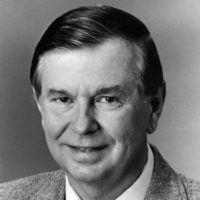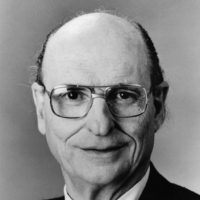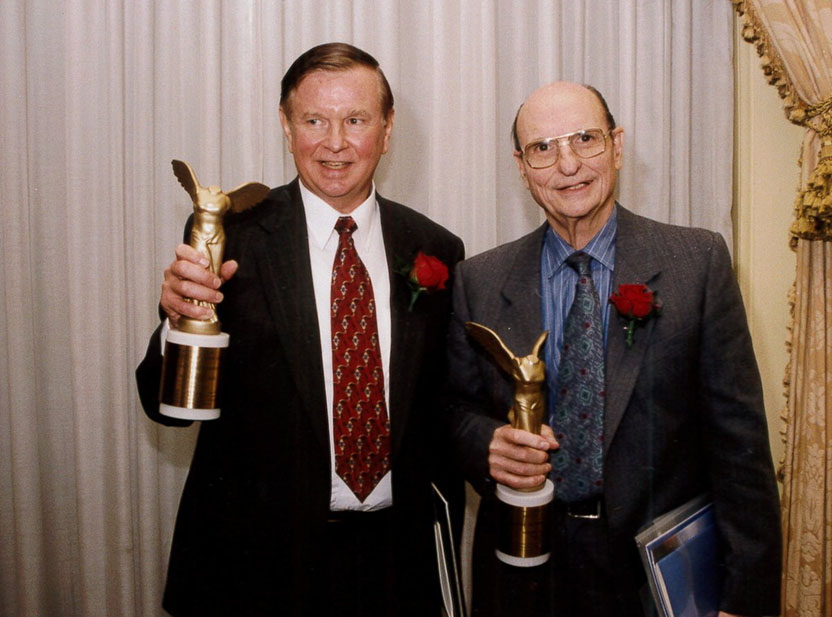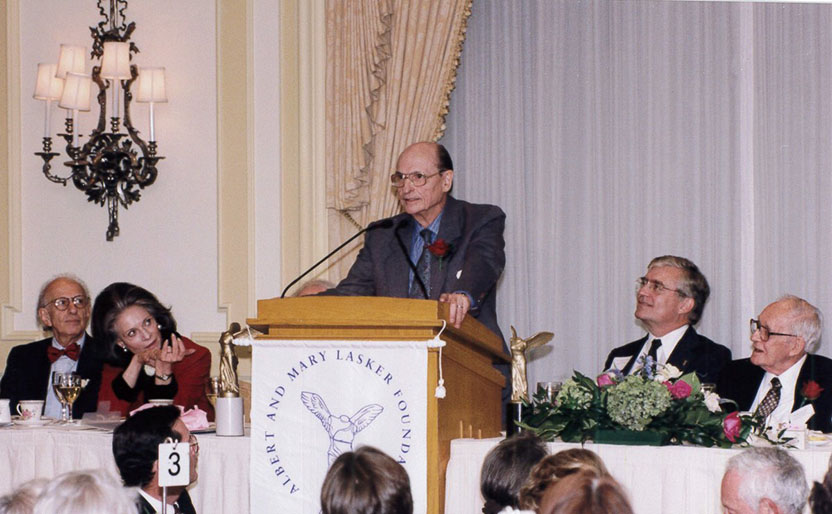
David W. Cushman
Bristol-Myers Squibb Pharmaceutical Research Institute

Miguel A. Ondetti
Bristol-Myers Squibb Pharmaceutical Research Institute
For developing an innovative approach to drug design based on protein structure and using it to create the ACE inhibitors, powerful oral agents for the treatment of high blood pressure, heart failure, and diabetic kidney disease.
David Cushman and Miguel Ondetti Like true love, the course of truly pathbreaking biomedical research seldom runs smooth, but persistence and commitment do pay off. The story of the long, productive collaboration between David Cushman, a biochemist, and Miguel Ondetti, a chemist, is a remarkable tale of the ups and down of experimental science which, in this case, ends on a high note with the design of an important new class of drugs for hypertension and congestive heart failure.
Cushman and Ondetti share the 1999 Albert Lasker Award in Clinical Medical Research for the discovery and development of captopril, the first orally active ACE inhibitor—the parent drug to what is today a pharmaceutical treasure trove of newer drugs in cardiovascular medicine.
“It would not be an exaggeration to say that when we started collaborating in the identification of angiotensin converting enzyme (ACE) inhibitors in the late 1960s, we had no idea of the impact that our work would eventually have on the study and management of cardiovascular diseases,” said Cushman and Ondetti a decade ago as they reviewed their work.
But it would be misleading to suggest that their accomplishments were the result of serendipity or good luck. In truth, their story is a prescient illustration of “rational drug design,” a concept that is much heralded today as something made possible by computer imaging and genome science. But in the late 1960s and early 1970s, when the Cushman-Ondetti story begins, they pursued rational drug design with little more than a clear idea, open minds, and what Cushman calls, “straightforward, simple, chemical thinking.”
Cushman and Ondetti have spent their professional lives at what is now the Bristol-Myers Squibb Pharmaceutical Research Institute in New Brunswick and Princeton, New Jersey. In the 1960s, ACE, which forms the hypertensive peptide angiotensin II from an inactive precursor angiotensin I, was recognized as a potential player in blood pressure regulation, but there were no good assays for characterizing either the enzyme or agents that inhibit its capacity to raise blood pressure.

David Cushman and Miguel Ondetti
Award presentation by Joseph Goldstein
One hundred years ago, two noteworthy events took place in Stockholm, Sweden. Both had far-reaching effects on the biomedical sciences. One was the settlement of Alfred Nobel’s controversial will and the creation of the Nobel Foundation. This event had immediate impact and is well known to all of us. The second Stockholm event, occurring at precisely the same time, involved a remarkable series of experiments that laid the groundwork for this year’s Lasker Award in Clinical Research.
In 1896, two physiologists at the Karolinska Institute, Robert Tigerstedt and Per Bergmann, injected extracts of kidneys into the bloodstream of rabbits, and they made a dramatic observation: The extracts produced an acute elevation in the blood pressure. These observations led Tigerstedt and Bergmann to propose that the kidney secretes a hormone with vasopressor properties. They named this hormone renin, befitting its renal origin, and they advanced the concept that renin could form the link between kidney disease and hypertension. The Swedish scientists published their results in 1898 in the Scandinavian Archives of Physiology. But unlike Alfred Nobel’s one-page will published in the same year, Tigerstedt and Bergmann’s 48-page article had no impact. Like Nobel, it lay buried in Sweden for the next 36 years.
Then, in 1934, Harry Goldblatt, a Cleveland physician, placed a clamp on the artery leading to the kidney of a dog and produced the first animal model of chronic hypertension. Goldblatt proposed that the decrease in blood supply causes the kidney to release a vasopressor substance. Goldblatt was unaware of the earlier discovery of renin. The connection between the Goldblatt kidney and renin was not made until the 1950s when scientists delineated the renin-angiotensin system, which is the major mechanism the body uses to control blood pressure.
Interview with David Cushman and Leon Rosenberg
Leon Rosenberg, Professor, Department of Molecular Biology and the Woodrow Wilson School of Public and International Affairs, Princeton University, interviews David Cushman, who shares the 1999 Albert Lasker Clinical Medical Research Award with Miguel Ondetti. Dr. Cushman is retired from the Bristol-Myers Squibb Pharmaceutical Research Institute in Princeton, NJ. Dr. Rosenberg is also President and Chief Executive Officer of the Funding First initiative of the Mary Woodard Charitable Trust.
Part 1: Developing Captopril Through ‘Pure Chemical Design’
Dr. Cushman says captopril’s significance from a basic research point of view is that it was developed through pure chemical design. He credits Dr. John Vane with suggesting angiotensin converting enzyme as a target for research at The Squibb Institute.
Rosenberg: Well Dave, let me start by congratulating you one more time on this marvelous achievement of winning the Lasker Award for Clinical Research. It’s a pleasure for me to have the opportunity to interview you in this connection.
Cushman: The pleasure is all mine, sir. I hope my brain is up to this. Six years have passed, and I have been doing a little more reading on what we did in the past, trying to catch up with it all. I hope I’ll have something to say for you.
Rosenberg: Dave, were you surprised?
Cushman: Yes, I was surprised. Although I guess I had known a couple of years earlier that we had been nominated. And I wouldn’t have expected it would have happened on the first try. So I was more delighted than surprised.
Rosenberg: Let me ask you to tell me what you think is the most important part of the work that you and Miguel and many, many other people did.
Cushman: Okay, I think that’s probably two-fold. I’ve been practicing this because somebody asked me the same question this morning. Well, I think that from a very basic research point of view, the most important aspect was that we actually discovered, probably developed, the first type of drug that was actually developed through pure chemical design. Not discovered in any way by serendipity, but almost every step in the design of the eventual drug was rational and based on chemical principals. And, of course, the obvious other side of this is that this end product that we developed, as we hoped, turned out to be of great medical significance and excited us very much in terms of its ability to help people and to actually pave the way for other developments in the medical community.
Rosenberg: Dave, when you say that the drug–we’re talking about captopril, of course–was developed absolutely through rational design, I guess the one place where there had to be some choice made was in the selection of the target. How did that come about?
Cushman: Well, that came about actually as one of many contributions made to my life and to our program at Squibb by Dr. John Vane, who was our consultant…who had just become a consultant, I guess at the Squibb Institute for Medical Research, when Arnold Welch took over as president. John had a lot of good ideas, and he pushed them, and he was also very helpful in my career. But this particular one was that he suggested that somebody at Squibb might be interested in studying a very unusual enzyme with great physiological potential, which was angiotensin converting enzyme. It was unusual as an enzyme, which appealed to me, because its mechanism was different than any other enzyme known at the time in that it knocked off the dipeptide residue from the carboxyl terminal into the peptide substrate–that substrate being angiotensin I, which is an immediate precursor of the potent hypertensive peptide angiotensin II.
And people had been arguing for a long time about the potential of angiotensin II in blood pressure elevation and hypertensive disease and possibly in other areas, too. So it was very exciting. We had here at one time a potential target for drugs in that the enzyme formed a substance, which might be overproduced in hypertension, and, on the other hand, we had a very interesting target from an enzymologist’s point of view because it was so unusual and very, very poorly characterized. So it left a lot of room to figure out a way to assay the enzyme and then to study its properties. And to hopefully develop inhibitors which might have great drug actions. So all those things turned out to be true, but we didn’t know that at the time.
Rosenberg: What year did that actually occur, those early conversations with John? And who was party to them?
Cushman: Well, as I recall, initially it was pretty much myself; my former boss in the biochemistry department; Zola Horovitz, who was head of the pharmacology department; and John. Somewhat later, Dr. Ondetti, my collaborator, became involved in this, and he became more interested in a different aspect of the snake venom peptide. But this would have been late 1967. I’m not sure of the exact month or anything.
Rosenberg: Can you tell me a little bit about what your response and that of your Squibb colleagues was to this suggestion by John Vane?
Cushman: Well, my response was very, very positive because I was working on a dead-end project. I mean we were doing a lot of hard work, but it was obviously not going anywhere, and I kind of drooled at the idea of working with peptidases. There are many more techniques available, you know, for the enzymologist to study them. And this was an enzyme that nothing was known about, so it was an absolutely open area for me to study as an enzymologist. So I was very, very excited about it. I know Zola Horovitz was also, but I’m not sure that anybody, of course, was expecting a whole lot out of it. In fact, it took us a long time before the company got extremely excited. Companies tend to get very excited about something when you’ve finally got that product that they know they can sell. But, you know, there are a lot of far-thinking people who thought this would be a good project to work on and thought it would be ideal for me too.

Miguel Ondetti interviewed by Leon Rosenberg
Miguel Ondetti interviewed by Leon Rosenberg
Leon Rosenberg, Professor, Department of Molecular Biology and the Woodrow Wilson School of Public and International Affairs, Princeton University, interviews Miguel Ondetti, who shares the 1999 Albert Lasker Clinical Medical Research Award with David Cushman. Dr. Ondetti, now retired, was senior vice-president for cardiovascular metabolic diseases at the Bristol-Myers Squibb Pharmaceutical Research Institute in Princeton, NJ. Dr. Rosenberg is also president and chief executive officer of the Funding First initiative of the Mary Woodard Charitable Trust, August 1999.
Part 1: Education In Argentina and Early Influences
Dr. Ondetti talks about his education at the University of Argentina, his mentor at the Squibb Institute in Buenos Aires, and his decision to come to the United States.
Rosenberg: Miguel, I’m delighted to have a chance to talk with you, first to congratulate you one more time on your being the recipient of this year’s Lasker Award for Clinical Research. As somebody who had reason to be associated with you at Bristol-Meyer Squibb, it is a particular pleasure to have a chance to interview you and to find out a bit about how this work came about. So let me ask you first…tell me where you were born…a bit about your early years. I know you were not born in the United States, but I’m curious as to your beginnings.
Ondetti: Yes, I was born in Buenos Aires, Argentina, and I received my education in Buenos Aires at the School of Science of the University of Buenos Aires. I came to Squibb because I was the recipient of a scholarship for training in scientific research to work with Dr. Deulofeu, who was then the head of chemistry at the Squibb Institute for Medical Research.
Rosenberg: Now, Miguel, this was not the Squibb Institute here? This was the Squibb Institute in Buenos Aires?
Ondetti: Yes, but it was really a branch of the Squibb Institute here that had been built in the early ’50s by the Squibb Company in Argentina.
Rosenberg: Was Dr. Deulofeu a senior person in the Squibb Institute in Argentina?
Ondetti: Yes. When I came to the institute, the head of the institute was Dr. Sordelli, who was a very well-known microbiologist. He was world-renowned in microbiology. He was the head of the institute and Dr. Deulofeu was the head of the chemistry part of it. I was working on a project proposed by Dr. Deulofeu on the chemistry of carbohydrates that was eventually part of my doctoral thesis.
Rosenberg: Would you say that Dr. Deulofeu was an important mentor for you in your early scientific years.
Ondetti: Oh, very much so. He had been my professor of organic chemistry at the University and for me was a representation of what research was or was meant to be in chemistry. He was the dean of chemistry in Argentina and recognized by a very large, long series of collaborators. So for me to work with him was not only a great learning experience, but really what encouraged me to continue in research.
Rosenberg: Miguel, how old were you when you first met Dr. Deulofeu and how long were you associated with him actively in research?
Ondetti: As I said, I met him first as a student in the University in 1953. But I started collaborating with him in 1956 until I came here in 1960.
Rosenberg: So you worked closely with him for four years.
Ondetti: Exactly.
Rosenberg: And maybe you’d like to tell us about the circumstances that led you to come to the US.
Ondetti: After I finished my doctoral thesis work with the scholarship from Squibb, I was offered a position as a full member of the scientific staff. So I joined them in 1957, and I was working on the isolation of natural product, alkaloid, from South American plants for three years. And in March of 1960, Dr. Deulofeu’s secretary called me to his office and said that Dr. Langlyke, who was then the head of the Squibb Institute here in the US, and he normally, routinely every year paid a visit to the Squibb Institute branch in Buenos Aires, that he wanted to talk to me. And when I went to the office, Dr. Langlyke right away off the bat asked me whether I wanted to work in the United States.
Then I asked him for how long and he said for as long as I wanted to work. That he was offering me actually a position, a permanent position of the Squibb Institute and that I had two days to think about it and give him an answer because he was leaving for the States in two days. So I discussed it very thoroughly with my wife, who was ready to open her office as a dentist, and we decided that we were going to take the chance, because we could always come back—and that was 39 years ago. We never did. So we’re still here. So that’s how I came to work at the Squibb Institute in the United States.
Rosenberg: Have you ever regretted, Miguel, that decision?
Ondetti: Well, no. Regretted, no. I have thought that there would have been a number of other things that I could have done if I had gone back and joined the handful of people who had been my classmates, that they are now in good positions, in very high positions at the University. But I didn’t, by the same token that I never regretted that I went to Squibb, an industrial lab, and I never left. I felt that I had found my niche in which I could work in collaboration, not only with chemists, but we also with biologists. That was very important to me.
Rosenberg: Do you think you would have discovered captopril if you had not come to the United States?
Ondetti: No. I guess the answer is almost certain.
Rosenberg: Why?
Ondetti: Well, because there were a number of circumstances that had to sort of come together. And even though I was always interested in chemistry that was connected with biology, it is more difficult to have that connection when you are working in a completely academic chemistry department. It’s much more feasible when you work in a pharmaceutical company. And I think that’s one of the key important points of my career.
